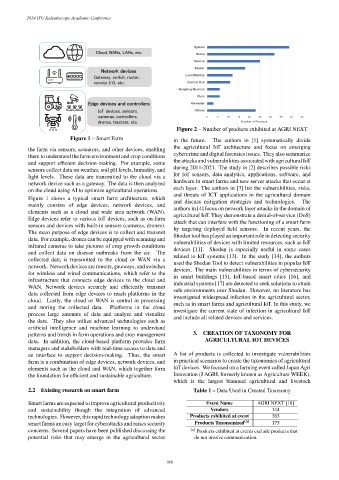Page 232 - Kaleidoscope Academic Conference Proceedings 2024
P. 232
2024 ITU Kaleidoscope Academic Conference
Figure 2 – Number of products exhibited at AGRI NEXT
Figure 1 – Smart Farm in the future. The authors in [1] systematically divide
the agricultural IoT architecture and focus on emerging
the farm via sensors, actuators, and other devices, enabling
cybercrime and digital forensics issues. They also summarize
them to understand the farm environment and crop conditions
the attacks and vulnerabilities associated with agricultural IoT
and support efficient decision-making. For example, some
during 2011-2021. The study in [2] describes possible risks
sensors collect data on weather, soil pH levels, humidity, and
for IoT sensors, data analytics, applications, software, and
light levels. These data are transmitted to the cloud via a
hardware in smart farms and new server attacks that occur at
network device such as a gateway. The data is then analyzed
each layer. The authors in [3] list the vulnerabilities, risks,
on the cloud using AI to optimize agricultural operations.
and threats of ICT applications in the agricultural domain
Figure 1 shows a typical smart farm architecture, which
and discuss mitigation strategies and technologies. The
mainly consists of edge devices, network devices, and
authors in [4] focus on network layer attacks in the domain of
elements such as a cloud and wide area network (WAN).
agricultural IoT. They demonstrate a denial-of-service (DoS)
Edge devices refer to various IoT devices, such as on-farm
attack that can interfere with the functioning of a smart farm
sensors and devices with built-in sensors (cameras, drones).
by targeting deployed field sensors. In recent years, the
The main purpose of edge devices is to collect and transmit
Shodan tool has played an important role in detecting security
data. For example, drones can be equipped with scanning and
vulnerabilities of devices with limited resources, such as IoT
infrared cameras to take pictures of crop growth conditions
devices [11]. Shodan is especially useful in some cases
and collect data on disease outbreaks from the air. The
related to IoT systems [13]. In the study [14], the authors
collected data is transmitted to the cloud or WAN via a
used the Shodan Tool to detect vulnerabilities in popular IoT
network. Network devices are routers, gateways, and switches
devices. The main vulnerabilities in terms of cybersecurity
for wireless and wired communications, which refer to the
in smart buildings [15], IoT-based smart cities [16], and
infrastructure that connects edge devices to the cloud and
industrial systems [17] are detected to seek solutions to attain
WAN. Network devices securely and efficiently transmit
safe environments over Shodan. However, no literature has
data collected from edge devices to reach platforms in the
investigated widespread infection in the agricultural sector,
cloud. Lastly, the cloud or WAN is central in processing
such as in smart farms and agricultural IoT. In this study, we
and storing the collected data. Platforms in the cloud
investigate the current state of infection in agricultural IoT
process large amounts of data and analyze and visualize
and include all related devices and services.
the data. They also utilize advanced technologies such as
artificial intelligence and machine learning to understand
patterns and trends in farm operations and crop management 3. CREATION OF TAXONOMY FOR
data. In addition, the cloud-based platform provides farm AGRICULTURAL IOT DEVICES
managers and stakeholders with real-time access to data and
an interface to support decision-making. Thus, the smart A list of products is collected to investigate vulnerabilities
farm is a combination of edge devices, network devices, and in practical scenarios to create the taxonomies of agricultural
elements such as the cloud and WAN, which together form IoT devices. We focused on a farming event called Japan Agri
the foundation for efficient and sustainable agriculture. Innovation (J AGRI, formerly known as Agriculture WEEK),
which is the largest biannual agricultural and livestock
2.2 Existing research on smart farm Table 1 – Data Used in Created Taxonomy
Smart farms are expected to improve agricultural productivity Event Name AGRI NEXT [18]
and sustainability though the integration of advanced Vendors 144
technologies. However, this rapid technology adoption makes Products exhibited at event 263
smart farms an easy target for cyberattacks and raises security Products Taxonomized (a) 175
concerns. Several papers have been published discussing the (a) Products exhibited at events exclude products that
potential risks that may emerge in the agricultural sector do not involve communication.
– 188 –

